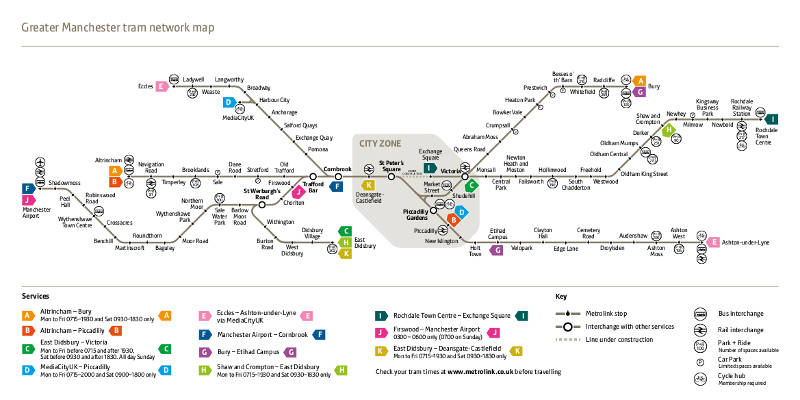The Manchester Metrolink has a length of 100 kilometers of railroad, 7 lines, and 6 functional routes.
The Metro´s working hours are between 6:00 am and midnight (12:00 am) all week long. During peak hours, the train frequency is between 5 and 8 minutes.
A one-trip single ticket for only one zone costs 1.20 pounds (GBP.)
The Manchester Metro has a direct connection to the airport through route number 6 (Manchester Airport-Victoria).
The Manchester Metro (Manchester Metrolink)
Manchester is the second most populated city of the United Kingdom of Great Britain, being home to almost 3.300.000 inhabitants in its metropolitan area.
Since the end of World War II, Manchester has become an important financial, artistic, cultural, and educational center for Europe, and an important place thanks to its press. In fact, many British entrepreneurs have considered this city as the best place to start a business in the country, being a better place than London itself.
Likewise, the economic growth experienced by the metropolis in the last decade has created a strong increment of the number of firms of the service sector in the city, diversifying significantly the number of jobs available in the city.
Tourism also deserves an honorable mention, since nowadays Manchester has become second most visited place by foreigners that visit the United Kingdom.
All of these factors forced the local authorities to present proposals of a new massive transportation service, with the goal of covering the increasing demand of the citizens. This is a consequence of the increase of the Manchester population.
At the beginning of the 80s, the possibility of using the old tramway railroads –which were functional during the 19th century- was being considered. These railroads were considered to be used as roads for a new light rail service, with the added benefit that these old railroads could become functional once again.
In 1984, after a couple of years had passed, the construction of the Manchester Metro was finally approved, and the metro was given the name Manchester Metrolink. However, the construction of the metro began four years later, on 1988.
The project was divided into three phases. The first phase was finished in 1992, the second one was finished on the year 2000, and the third phase was finished recently, that is, on 2013.
Currently, this transportation system has a 100 kilometer-long route, 7 lines, and 6 operational routes.
Lines and routes.
The Manchester Metro has 7 operational lines, which are also used by 6 light rail commercial routes. These 7 lines have trains that travel through 100 kilometers of railroads, and they have a total number of 93 stations.
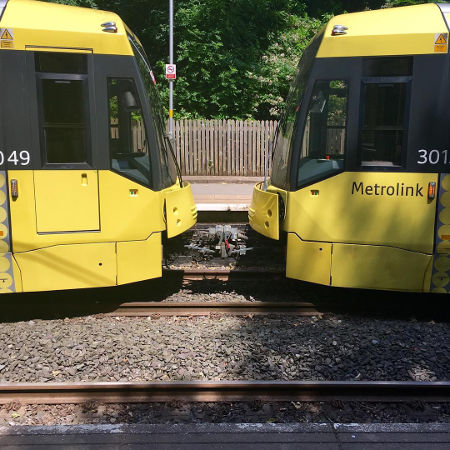 Metrolink
Metrolink
The routes are connected to the four cardinal directions, and all of the routes meet at the center. During 2017, over 44 million passengers rode the metro. As impressive as this number is, the number of yearly passengers of the metro keeps increasing.
The lines and routes of the Manchester Metrolink will be described below:
Airport Line (Route 6)
The Airport Line goes through downtown Manchester, as well as many other zones of Great Manchester. This line is 14.5 kilometers long, and offers service to 15 stations.
Its name comes from the fact this line connects downtown Manchester with the airport, as well as going through the regions of Castlefield, Firswood, Chorlton-cum-Hardy, Northern Moor, Wythenshawe, Baguley, Ringway, among others.
It started operations on November 3rd, 2014. This is the most recent line.
On the original blueprints of the metro there was a planned expansion towards the South Manchester University Hospital and the Newall Green suburb. However, this expansion was discarded in the end.
On this line, the route 6 trains transit, which is the route between the Manchester Airport and Victoria.
Altrincham Line (Routes 1 and 2)
The Altrincham Line departs from downtown Manchester to Altrincham, which is in Great Manchester. This route is 10.4 kilometers long, in which 11 stations have been built. Its name comes from the Altrincham Interchange terminal station, which lies right at the Altrincham Interchange area. The trains from this line transit by the communities of Brooklands, Sale, Stretford, Old Trafford, and Timperley.
It was finished by June 15th, 1992, when it was opened for business. Most of the railroads of this line are used by railway lines recovered from the 19th century. The owners decided to use old trains from these railway lines since they didn´t have newer trains when they made this line, which was one of the first lines to be planned.
On this line, you will find routes 1 (Altrincham-Bury), and 2 (Altrincham–Piccadilly).
Bury Line (Routes 1 and 4)
The Bury Line is comprised of the route that goes between downtown Manchester and the Bury area, which is in Great Manchester.
During its first months, this line was united to the Altrincham Line. However, on April 6th, 1992, the people in charge of the project decided to separate both lines, making the Bury Line an official line.
The trains of this line transit by the regions of Bury, Radcliffe, Besses o' th' Barn, Prestwich, Prestwich and Cheetham Hill.

This line is comprised of 10 stations, all of which are located within a 15.9 kilometer-long route. It was almost entirely built on top of railroad restored from the now-defunct Manchester tramway. On this railroad, the trains transit by routes 1 (Altrincham-Bury) and 4 (Bury-Piccadilly.)
East Manchester Line (Route 3)
The East Manchester Line covers the eastern region of Manchester and great Manchester since its route goes through the areas of Ashton-under-Lyne, Droylsden and Audenshaw.
This route is 10 kilometers long, and it has 13 stations, which are spread throughout the regions of Ashton-under-Lyne, Audenshaw, Droylsden and Clayton.
It started operations on February 11th, 2013. However, there are still works being done to this line, since there are plans to expand its route towards the town of Stalybridge.
On this line, the trains from route number 3 transit (Eccles–Ashton-under-Lyne).
South Manchester Line (Route 5)
The South Manchester Line unites downtown Manchester with the town of Didsbury, which is located to the south of Great Manchester.
This route is 7.1 kilometers long, in which 8 stations lie. These stations are spread throughout the towns of Didsbury, Withington and Chorlton-cum-Hardy.
Even though this line was planned from the very beginning, its construction suffered considerable delays due to budget issues. This line was changed to being part of the third phase of the construction of the Manchester Metro. In this regard, the construction of the stations began way back on the year 2000, to be inaugurated fully completed on July 7th, 2011.
The trains from route number 5 (East Didsbury–Rochdale Town Centre) transit on this line.
Eccles Line (Route 3)
The Eccles Line light rail line connects downtown Manchester with the region of Eccles through Salford Quays. This route has a length of 6.4 kilometers, in which there are 11 stations available through the regions of Eccles, Ladywell, Weaste, Langworthy and Salford Quays.
The construction works on this line began on 1997, when two firms agreed to do this project. It is important to point out that this project was being discussed since 1980, since the region of Salford Quays was experiencing a considerable increase in population and didn’t have any efficient public transportation system. Finally, the line was inaugurated on July 21st, 2011.
On this line transit the trains of route number 3 (Eccles–Ashton-under-Lyne).
Oldham and Rochdale Line (Route 5)
This line connects downtown Manchester with the northern region of Great Manchester through a 22.5 kilometer-long route and 20 stations. This makes it the longest line of the Manchester Metro.
This line serves the areas of Rochdale, Newbold, Firgrove, Milnrow, Newhey, Shaw and Crompton, Derker, Oldham, Chadderton, Newton Heath and Monsall.
Its trains transit through a railroad that dates back to the 19th century, which was later restored to become part of the Manchester Metrolink. This way, during the year 2012, this light rail line was officially inaugurated. The trains from route 5 (East Didsbury–Rochdale Town Centre) transit in here.
 Manchester Metrolink
Manchester Metrolink
Connections
The Manchester Metro allows you to transfer to other systems of transportation, such as buses or fast trams.
We will see below detailed information about the system’s stations that connect directly to other transportation services so that you can move throughout the city:
- Altrincham Interchange Station: This station is located in the town of Altrincham –on the Altrincham Line-, and the trains from routes 1 (Altrincham–Bury) and 2 (Altrincham–Piccadilly) transit in here. It has a connection with the suburban rail service of Mid-Cheshire Line. This station also offers transfers to the bus services of the firm Stagecoach Manchester, Warrington's Own Buses, Warrington Coachways and Vale Travel.
- Navigation Road Station: It is located on the Altrincham area, and it is covered by the Altrincham Line. This station is covered by the trains from routes 1 (Altrincham–Bury) and 2 (Altrincham–Piccadilly). It connects with the Mid-Cheshire suburban railway line. It also makes a connection with the bus services of the firm Manchester Community Transport.
- Deansgate-Castlefield Station: It is located in the Castlefield area –right at downtown Manchester-, and it is visited by trains of routes 1 (Altrincham–Bury), 2 (Altrincham–Piccadilly), 3 (Eccles–Ashton-under-Lyne), 4 (Bury–Piccadilly), 5 (East Didsbury–Rochdale Town Centre) and 6 (Manchester Airport–Victoria). It has a connection with the suburban rail lines of Manchester, South Junction and Altrincham Railway.
- Shudehill Interchange Station: It’s located on downtown Manchester, and it has trains from routes 1 (Altrincham–Bury), 2 (Altrincham–Piccadilly) and 6 (Manchester Airport–Victoria). It has a connection with the bus services of the firms Arriva North West, First Greater Manchester, Manchester Community Transport, Megabus and Stagecoach Manchester.
- Manchester Victoria Station: It is located in downtown Manchester, and it has trains from routes 1 (Altrincham–Bury), 4 (Bury–Piccadilly), 5 (East Didsbury–Rochdale Town Centre) and 6 (Manchester Airport–Victoria). It has a connection with the suburban rail services of the North TransPennine, Calder Valley Line, Huddersfield Line, Ribble Valley Line, Manchester to Preston Line, Manchester to Southport Line, Kirkby branch Line and the Liverpool to Manchester Line.
- Bury Interchange Station: It is located on the Bury area, and it has trains from routes 1 (Altrincham–Bury) and 4 (Bury–Piccadilly). It has a connection with the bus services of the firms First Greater Manchester, Rosso, Arriva North West and Stagecoach Manchester.
- Piccadilly Gardens Station: It is located in the Piccadilly Gardens area, and the trains that come in here are the trains from routes 2 (Altrincham–Piccadilly), 3 (Eccles–Ashton-under-Lyne) and 4 (Bury–Piccadilly). It has a connection to the bus services of the firms First Greater Manchester, Magic Bus, Stagecoach Manchester, Arriva North West, Diamond Bus North West and Manchester Community Transport.
- Manchester Piccadilly Station: It is located in downtown Manchester, and it has trains that come from routes 2 (Altrincham–Piccadilly), 3 (Eccles–Ashton-under-Lyne) y 4 (Bury–Piccadilly). It has a connection with the suburban rail service of the Welsh Marches Line, Chester to Manchester Line, Liverpool to Norwich, North TransPennine, South TransPennine, TransPennine North West, and the Liverpool to Manchester Line.
- Eccles Interchange Station: It is located on the Eccles area, and it has trains coming from route 3 (Eccles–Ashton-under-Lyne). It has a connection with the bus services of the firms First Greater Manchester, Arriva North West, Manchester Community Transport, Diamond Bus North West and Stagecoach Manchester.
- Ashton-under-Lyne Station: It is located on the Ashton-under-Lyne area, and it has trains coming from route 3 (Eccles–Ashton-under-Lyne). It has a connection with the suburban rail route of the Huddersfield Line.
- Rochdale Railway Station: It is located on the Rochdale area, and it has trains coming from route 5 (East Didsbury–Rochdale Town Centre). It has a connection with the suburban rail route of Calder Valley Line.
- Manchester Airport Station: It is located on the Ringway area, and it has trains coming from route 6 (Manchester Airport–Victoria). It has a connection with the railway firms of Northern, TransPennine Express and Arriva Trains Wales.
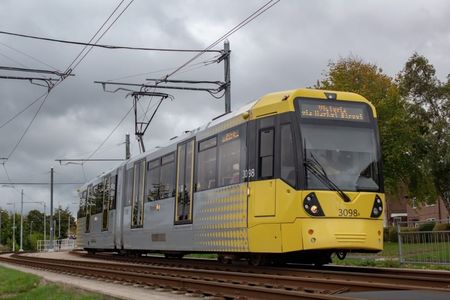 Martinscroft tram stop
Martinscroft tram stop
Schedule
The Manchester Metro starts operations at 6:00 am, and it operates continuously until midnight (12:00 am). It repeats these same working hours throughout the 7 days of the week. This schedule is specially done for the benefit of the city’s workers, since the metro closes very early if there are leisure events celebrated in the city.
Trains tend to reach the stations with a frequency between 12 and 20 minutes, depending of the time of day. During peak hours, the waiting time ranges between 5 and 8 minutes.
Fares
The Manchester Metro’s fares depend on the number of kilometers travelled by the user. Also, the system is divided in four great zones. These zones are begin at downtown Manchester, and end at the outskirts of Great Manchester. In other words, the metro’s fares depend on the number of zones travelled by each passenger.
The prices and types of tickets are the following:
Metrolink Single Ticket: This ticket gives you a single ride, which allows you to go towards one station. However, you can disembark at a station and board the train again as long as you do it within two hours, which is the time when your ticket expires.
- 1 Zone: 1.20 GBP.
- 2 Zones: 2.60 GBP.
- 3 Zones: 3.80 GBP.
- 4 Zones: 4.40 GBP.
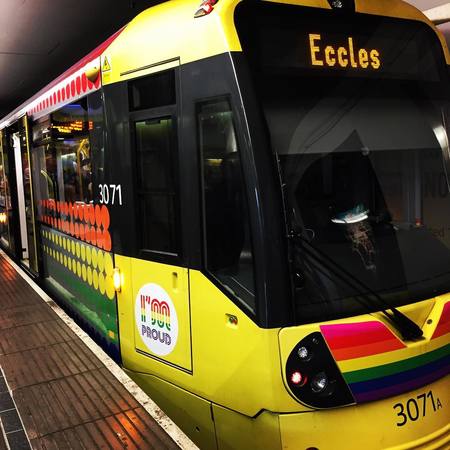 Manchester Metrolink Fares
Manchester Metrolink Fares
Metrolink Return Off-Peak Ticket: This option allows you to make a round trip within two stations, as long as you begin your journey after 9:30 am.
- 1 Zone: 1.60 GBP.
- 2 Zones: 3.20 GBP.
- 3 Zones: 4.00 GBP.
- 4 Zones: 4.60 GBP.
Metrolink Return Peak-Time Ticket: With this ticket you can make a round trip between two stations at any time of the day. It’s only valid from Monday to Friday.
- 1 Zone: 1.80 GBP.
- 2 Zones: 4.00 GBP.
- 3 Zones: 5.80 GBP.
- 4 Zones: 6.60 GBP.
Metrolink Off-Peak All Day TravelCard: You can only use this service if you have this card, which is called the TravelCard. Its price is of 5.40 pounds sterling (GBP.) This card allows you to travel all day long in the light rail trains of the Metrolink, with the only condition that you need to start your journey after 9:30 am.
- 1 Zone: 5.40 GBP.
- 2 Zones: 5.40 GBP.
- 3 Zones: 5.40 GBP.
- 4 Zones: 5.40 GBP.
Metrolink Anytime All Day TravelCard: This offer is only valid through this card, which is refillable. Its price is of 7.60 GBP. It allows you to travel on the system’s trains as many times as you want for a whole day.
- 1 Zone: 7.60 GBP.
- 2 Zones: 7.60 GBP.
- 3 Zones: 7.60 GBP.
- 4 Zones: 7.60 GBP.
Metrolink Weekend Travelcard: You only get access to this offer through this card. Its price is of 6.20 GBP. It allows you to travel on the light rail trains beginning at 6:00 pm on Fridays, and ending at night on Sunday.
- 1 Zone: 6.20 GBP.
- 2 Zones: 6.20 GBP.
- 3 Zones: 6.20 GBP.
- 4 Zones: 6.20 GBP.
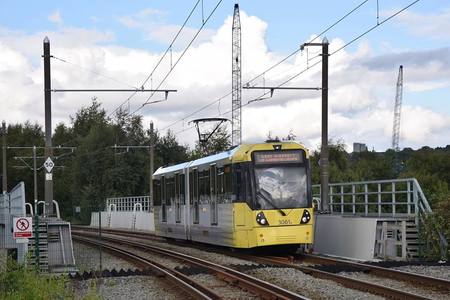 Manchester Metrolink
Manchester Metrolink
Metrolink 7-Day Season Ticket: With this pass, you can travel on the Manchester Metro for as many times as you want within a 7 day period.
- 1 Zone: 7.20 GBP.
- 2 Zones: 16.20 GBP.
- 3 Zones: 23.40 GBP.
- 4 Zones: 28.40 GBP.
Metrolink 28-Day Season Ticket: This pass allows you to travel on the system’s trains without any limit for 28 days straight.
- 1 Zone: 26.00 GBP.
- 2 Zones: 55.00 GBP.
- 3 Zones: 77.00 GBP.
- 4 Zones: 93.00 GBP.
Metrolink Annual Season Ticket: With this pass, you can travel for as many times as you want on the system’s trains for a whole year.
- 1 Zone: 290.00 GBP.
- 2 Zones: 620.00 GBP.
- 3 Zones: 880.00 GBP.
- 4 Zones: 1,050.00 GBP.
Children and young people between five and 16 years of age are entitled to a 50% discount on their journey’s fares.
Note: Prices may vary depending on the total distance that you may travel on the light rail trains of the Manchester Metro.
Rules
- You cannot consume alcohol within the Manchester Metro’s facilities, and you cannot board the trains while drunk either.
- You are not allowed to tamper with your tickets by writing on them, and you aren’t allowed to damage them in any other way.
- You are not allowed to use the Manchester Metro’s facilities to do recreational activities such as skating o riding a bike.
- You cannot have your pets too close to the trains once the trains start moving.
- It is prohibited to access the trains with firearms or with explosive materials.
- It is not allowed to walk in the light rail trains of the system while carrying a fuel tank.
- You cannot smoke neither at the stations nor the trains of the Manchester Metrolink.
- You cannot consume food while you use the vehicles of the system nor while you wait for the next train to arrive.
- You won’t be able to use the light rail trains if you are under the influence of illegal substances.
- You are not allowed to carry animals in the trains of the system, with the only exception of guide dogs.
- It is possible to carry your bike in the trains’ wagons, as long as there is enough space to allow it. Your bike should not block nor disturb other passengers.
- The use of inappropriate language is prohibited while you travel on the trains of the system.
- You can only listen to multimedia content via the use of headphones.
- You cannot hand out flyers, pamphlets, or any type of advertisement within the facilities of the Manchester Metro.
- You cannot travel on the trains if your clothes are wet or covered in any substance that could stick to the seats, or if you have body odor.
- Make sure that your clothes do not have inappropriate words written on them. Otherwise, you will be denied access to the trains.
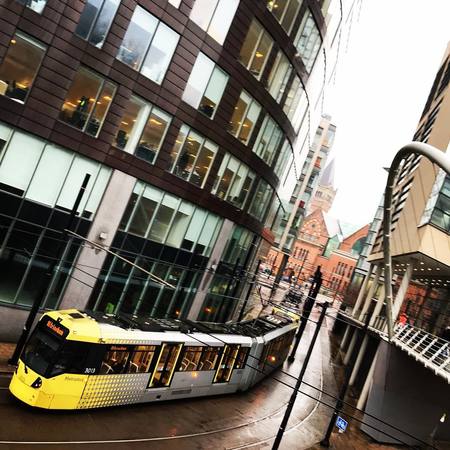 Metrolink, UK
Metrolink, UK
Connection with the airport
The Manchester Metro has a direct route that is in charge of transporting the passengers from downtown Manchester to the Manchester Airport.
This route is route number 6 (Manchester Airport–Victoria), in which the trains from the Airport Line transit. This line was specifically designed with this purpose in mind. The working hours for the trains that drive on this line are longer than usual, since these trains offer service from Monday to Thursday beginning at 3:45 am, and they stop operating at 11:10 pm. During weekends, that is, on Fridays, Saturdays, and Sundays, the trains work from 3:45 am to 12:10 am.
The vehicles from route 6 reach directly to the airport, so you don’t have to worry about boarding an additional means of transportation.
Nevertheless, if you prefer it, outside of the facilities you will find taxi lines, buses, rent-a-car firms, and suburban rail services, in case that your destination is not within the center of the metropolis. In any case, there are plenty of alternatives to fit the different needs of different users.
Touristic attractions
Manchester’s cultural heritage can be clearly seen on its streets, which mixes the modern culture of the 21st century and Manchester’s industrial history of the 19th and the 20th century.
One of the most iconic buildings in the city is the Manchester Cathedral, which is located a few blocks from the Exchange Square station. This station is served by the trains of route number 5. This church dates back from 1421, but it has received considerable modifications throughout its history. Some of its most notable changes were made during the Victorian era. Its architecture has a gothic style.
Thousands of tourists visit this cathedral each year. They are attracted to this place not only for religious purposes, which is the reason that this church exists in the first place, but also because of the beautiful design of its façade. Since it is located right at the center of downtown Manchester, it is recommended that you take the time to visit this cathedral and get to know it. While you visit it, also try to get to know the history of the surrounding place.
Media
Metro map of Manchester
Map via www.metrolink.co.ukSee map full resolution. It may take a little bit to load.
Download map.
Manchester MetroLink map
- Also Known As: MetroLink
- Passengers/Day 95000
- Fares:
- 24h operation:
- Air Conditioning:
- Walk between platforms:
- Driverless trains:
- Screen Doors Platforms:
- Max. Speed: 80km/hkm/h
- Operator: RATP Group5
- £7.00
- Manchester Metro Official Website
Help us
If you consider that the information we provide is wrong, not accurated, outdated, translation contains errors, and you would like to help us to improve the file...you can contact us here.
Feel free to contact us if you dont find the system you're looking for and we'll add it as soon as we can!
Thank you very much!







